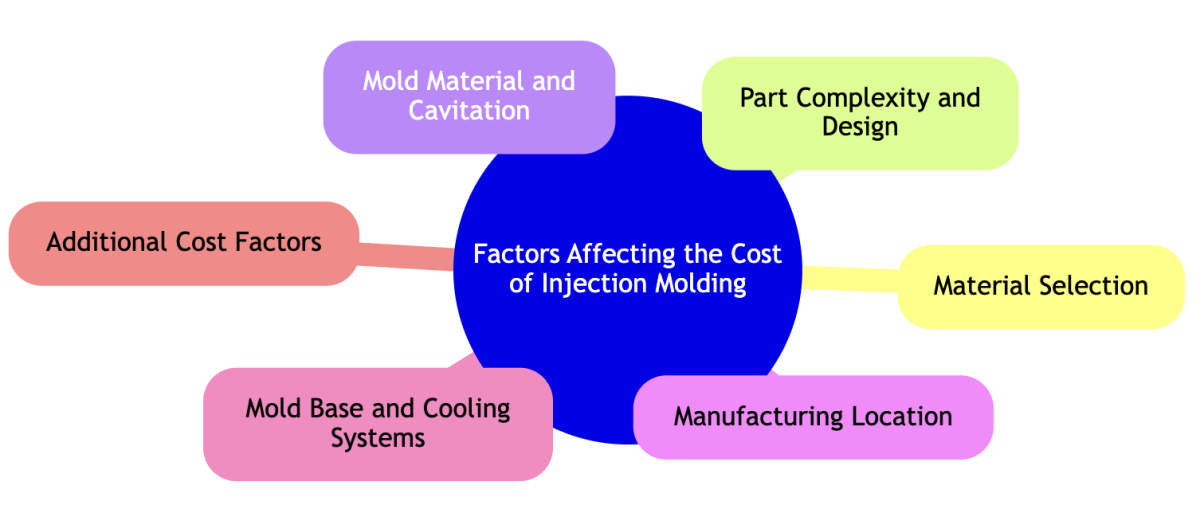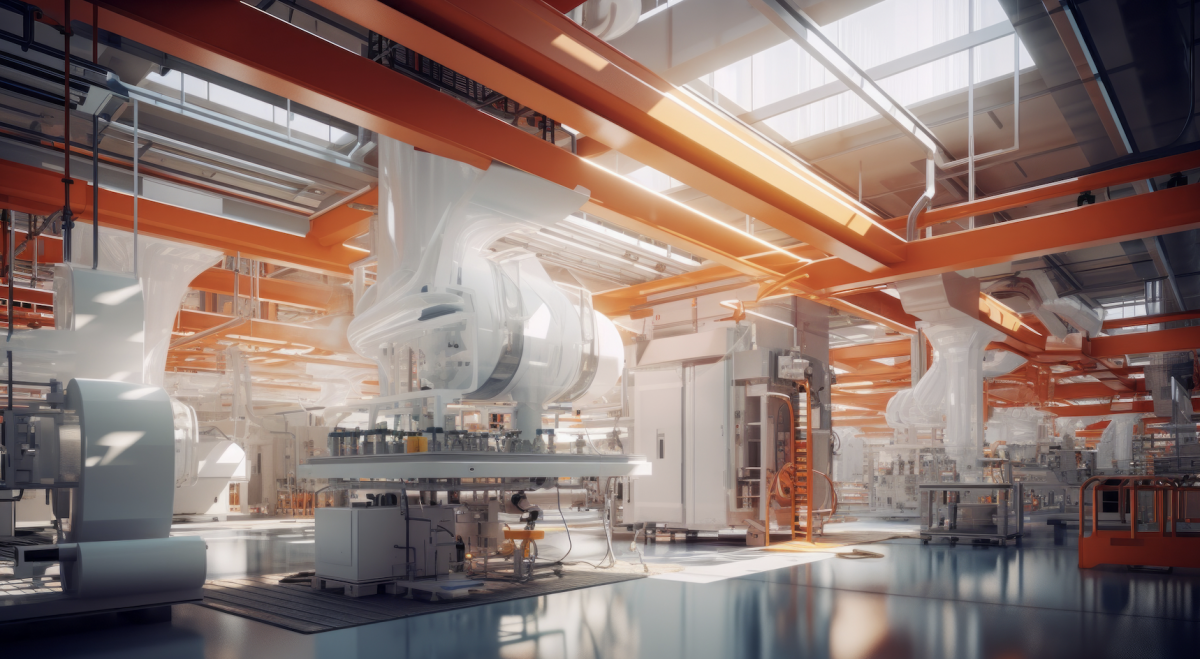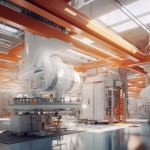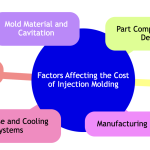Introduction - Plastic Injection Molding Costs
Various factors influence the cost of injection molding, each playing a crucial role in the final price tag of molded parts. From the selection of materials to the complexity of the design, understanding these variables is key to managing costs effectively. This guide dives deep into the primary factors that mold the financial aspects of injection molding, offering insights to navigate the complexities of this manufacturing process.
If you want to work with the best Injection Molding Company around - JDI Plastics is standing by!
key takeaways
- Importance of material selection
- Impact of part complexity and design
- The role of mold material and cavitation
- Influence of manufacturing location
- Considerations for mold base and cooling systems

Material Selection
The choice of resin is a pivotal decision in the injection molding process, significantly affecting cost and quality. Resins vary widely in price based on their properties, such as color, additives, quality, and availability. High-performance materials may offer better properties but come at a higher cost. Conversely, more common materials might reduce expenses but at the expense of performance.
- Polyethylene (PE): Cost-effective and versatile, suitable for a wide range of applications.
- Polycarbonate (PC): Offers high strength and transparency but at a higher price point.
- ABS: A common choice for its balance of properties and cost.
- Nylon: Known for its strength and flexibility, though material costs can be high.
- Polypropylene (PP): Economical and resistant to chemicals, a popular choice for many industries.
Part Complexity and Design
The complexity of a part's design directly impacts the cost of injection molding. Intricate designs require more sophisticated molds, increasing both the initial investment and the per-part cost. Tolerances, undercuts, and surface finishes add layers of complexity to the mold design, pushing costs higher.
Manufacturability plays a critical role in balancing design complexity and cost. Simplifying designs without compromising on functionality can lead to significant savings. For instance, minimizing undercuts or opting for simpler surface finishes can reduce mold complexity and, by extension, cost.
The dance between design complexity and manufacturability is delicate. Engineers must strive for a balance that meets the product's requirements without inflating costs unnecessarily. This balance ensures that the final product is not only functional and aesthetically pleasing but also economically viable.
Mold Material and Cavitation
Choosing the right mold material is critical in injection molding, as it directly affects both the cost and longevity of the mold. Steel molds, known for their durability, are ideal for high-volume production runs but come with a higher upfront cost. Aluminum molds, on the other hand, are more cost-effective for shorter runs due to their lower cost and faster machining times, though they wear out faster than steel molds.
- Assess Production Volume: High-volume projects benefit from steel molds, while aluminum molds are cost-effective for low to medium volumes.
- Consider Part Complexity: Complex parts with fine details often require the superior finish and durability of steel molds.
- Evaluate Lead Times: Aluminum molds can be produced faster, making them suitable for projects with tight deadlines.
- Budget Constraints: If initial costs are a concern, aluminum molds offer a lower entry point.
- Longevity and Maintenance: For long-term use, steel molds offer greater durability and lower maintenance costs.
Manufacturing Location
The choice between domestic and offshore manufacturing can significantly impact the cost of injection molding projects. Domestic production often commands higher labor rates but benefits from shorter lead times, higher quality standards, and easier communication. Offshore manufacturing can reduce labor costs substantially but may introduce challenges such as longer lead times, potential quality issues, and the complexities of international logistics.
Mold Base and Cooling Systems
The selection of a mold base and the design of cooling systems are pivotal factors that influence both the cost and quality of injection molded parts. An optimal mold base and cooling system design ensure efficient production and high-quality parts, while also affecting the overall mold cost.
Table 1: Cooling System Options and Cost Implications
|
Cooling System Type |
Description |
Cost Implications |
|
Conventional |
Straight or U-shaped channels |
Lower initial cost, but may result in uneven cooling |
|
Bubblers |
Use water or air to cool specific areas |
Moderate cost, better for cooling thick sections |
|
Conformal Cooling |
Channels that follow the mold surface contour |
Higher initial cost, but offers uniform cooling and reduced cycle times |
Choosing the right cooling system is crucial for maintaining part quality and minimizing cycle times. Conformal cooling systems, while more expensive upfront, can offer significant savings in the long run through improved efficiency and reduced scrap rates.
Additional Cost Factors
Gate and Runner System
The gate and runner system in an injection mold directs the flow of molten plastic into the cavities. The design of these systems significantly impacts both the mold cost and the quality of the final part. For instance, a hot runner system, while more expensive, can reduce waste and improve cycle times by keeping the plastic molten throughout the process. Conversely, a cold runner system might be less costly upfront but can lead to higher material waste and longer cycle times. The choice between these systems depends on the project's specific requirements, including the type of plastic used, the design of the part, and the desired production efficiency.
Mold Finish and Texture
The finish on the mold itself determines the surface finish of an injection molded part. High-gloss finishes require polished molds, which are more expensive to manufacture. Textured finishes, used to hide defects or for aesthetic purposes, can also add to the mold cost due to the additional processing required. The level of finish should be chosen based on the requirements of the final part, balancing the need for appearance with cost considerations. Advanced finishes can significantly enhance the product's appeal but will also reflect on the project's budget.
Production Volume and Economies of Scale
The production volume plays a crucial role in determining the cost per part. Higher production volumes can justify the investment in more durable and expensive mold materials, as the cost can be amortized over a larger number of parts. Economies of scale can be achieved, reducing the overall cost per part as production numbers increase. This factor is critical when selecting mold materials and types, as it can influence the decision between more expensive, long-lasting molds and less costly, shorter-lived alternatives.
Final Thoughts - JDI Plastics
Understanding the factors that influence the cost of injection molding is crucial for optimizing production and ensuring the quality of the final parts. Material selection, part design, mold material and cavitation, manufacturing location, and additional factors such as the gate and runner system, mold finish, and production volume all play significant roles in the cost structure of injection molding projects.
JDI Plastics stands at the forefront of the injection molding industry, leveraging years of expertise to navigate these complexities. Our commitment to excellence ensures that we optimize these factors for the most cost-effective and high-quality injection molding solutions. With JDI Plastics, clients gain a partner dedicated to delivering excellence in every project, maximizing value without compromising on quality.








